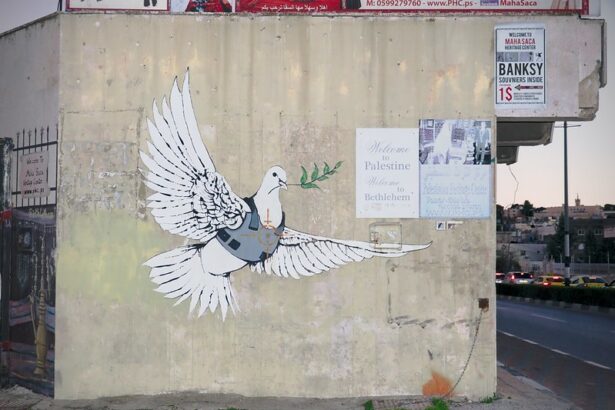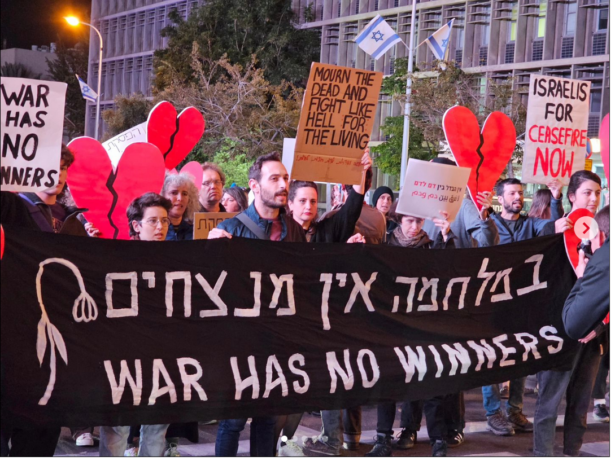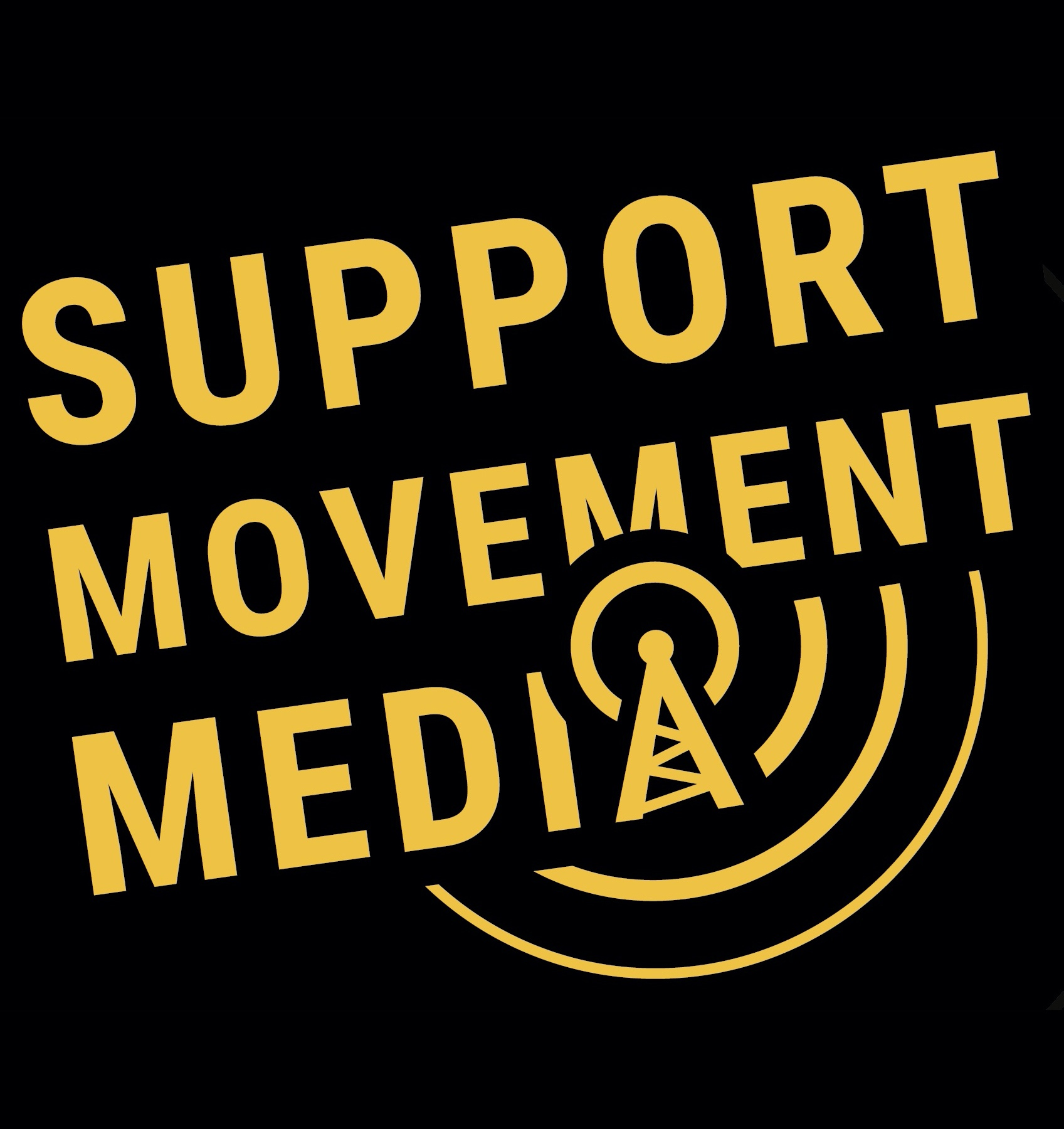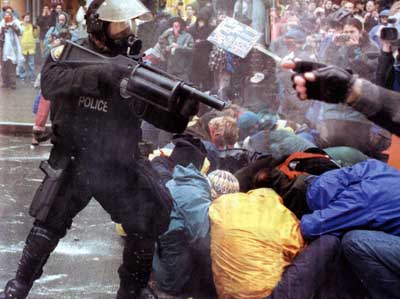In the past few weeks, the number of innocent Palestinian civilians killed in attacks by the Israeli government has reached unprecedented levels. Both a majority of people around the world and a majority of governments oppose the mass atrocities against civilians in Gaza. Why is this common-sense view not translated into action that stops these international crimes? And what can normal people do to end atrocities in Gaza and elsewhere?
Before answering these questions, I would like to start from my personal experience on the day this last round of violence started.
Like a scene in a horror movie, my Oct. 7 started the way many other Saturday mornings do — my 3-year-old daughter woke me up with a cry: “Aba, Aba!” (Hebrew for dad). But the normal morning shattered into pieces as I saw the news from Gaza.
Previous Coverage
 7 steps to end the cycle of violence in Israel and Palestine
7 steps to end the cycle of violence in Israel and PalestineMy heart pounding, I immediately opened my family and friends WhatsApp chat groups. Living in Ann Arbor, where I lead a research project on global governance, wars and civil resistance at the University of Michigan, I am seven hours behind most of my family in Israel. While I was relieved to learn that they were all fine, I soon discovered some friends had lost family members in the Hamas attack or had them taken hostage. Palestinian friends in Gaza and the West Bank were posting on social media that the Israeli army had started attacking and that civilians were being killed. The Israeli government soon declared war.
Like many millions around the world, I was scrolling through pictures in my news feed in shock. I couldn’t stop thinking of the question I am often asked by my students when we talk of wars and mass atrocities in class: “How can this be stopped?” As I tell my students, my inconvenient answer starts not with a “they” but with a “we” — the atrocities against civilians in the Israeli kibbutzes and in the Palestinian city of Gaza are a symptom of a system we have built, a system that requires our active or passive consent daily. We can re-build that system if we choose to. We have the power, and therefore the responsibility, to change the system that allows the atrocities in Gaza.
Resisting war, occupation and apartheid
Hamas’s attack that day killed more than 1,200 Israelis, including more than 40 children. Even before we knew this, it was clear the attack was serious enough to register as a societal shock in Israel — something comparable to what Sept. 11 was to Americans.
Within a few hours, the Israeli army started attacking the Gaza Strip. Since then, those attacks have killed over 22,500 Palestinians, with the majority of them being children and women, who do not usually participate in fighting. To give some perspective: The United States killed fewer civilians in Afghanistan during its 20 years of occupation — and Afghanistan’s population is about 20 times larger than Gaza’s. More specifically, in Afghanistan, one in 3,225 civilians were killed by the U.S. government in over 20 years. In Gaza, Israeli government attacks are estimated to have killed one in 128 civilians in under three months.
Previous Coverage
 Why Israeli army refusers are crucial to ending the cycle of violence
Why Israeli army refusers are crucial to ending the cycle of violenceServing as a volunteer on the board of Refuser Solidarity Network, a global network of 8,000 people who function as an international base of support for war resisters and peace activists in Israel, I have spent many nights and weekends since Oct. 7 working to amplify the voices of Israeli war resisters, trying to help in any way possible.
This was and is a difficult period for war resistance, anti-occupation and anti-apartheid groups in Israel. (Again, this is perhaps comparable to U.S. antiwar organizing challenges in the post 9/11 period). Binational groups of Jews and Palestinians working for peace together have faced significant strains, dealing with two national narratives of the events that were at least initially largely unreconcilable. At one point, the national head of the police, Yaakov “Kobi” Shabtai, threatened to send antiwar protesters to Gaza. “Whoever wants to become an Israeli citizen, welcome,” Shabtai said. “Anyone who wants to identify with Gaza is welcome. I will put him on the buses heading there now.”
The police have also refused to authorize antiwar demonstrations and conferences since the beginning of the war, particularly in Arab towns in Israel. A small invitation-only demonstration organized by a few former parliament members was met with arrests, despite being under the 50-person limit for which police authorization is required. Four former parliament members — all Palestinian citizens of Israel — were arrested by police, sparking demonstrations in Tel Aviv and Jerusalem, only to be met with more arrests. When Hadash, a socialist Arab-Jewish parliamentary front, organized an antiwar conference, police threatened the venue owner to retaliate if he did not cancel the event.
The network I volunteer with has been documenting and amplifying these antiwar voices — along with the police attacks against them — on social media and in our newsletters, while also coordinating international solidarity to help them. While it has taken up nearly every free moment, it is inspiring to see the Israeli antiwar movement find a way to focus on empathy and stopping the endless cycle of violence, even in this time of extreme hurt.
For 15 years Israeli war resisters have been telling Israelis that the status quo in Gaza in unsustainable — that we cannot continue to keep millions of Palestinians in a large open-air prison and expect this to go on forever, or to end well. No amount of F-16 planes, billion dollar walls and high-tech weaponry funded annually by billions of American taxpayer dollars can change that reality. Even before the Israel-Hamas war, a majority of citizens in global north countries opposed the status quo in the Palestinian-Israeli conflict, and supported an end to the Israeli occupation and apartheid.
Citizens in poor countries are unfortunately not often surveyed on their views on global politics, including the Palestinian-Israeli conflict, but the governments in the Global South publicly state that the Israeli occupation of the Palestinians territories was the root cause of the conflict. At the same time, a majority of governments in various international organizations repeatedly vote for resolutions against the Israeli rule over the Palestinian Territories. And yet — because our international system is broken — this worldwide consensus does not (and will not) translate into action to stop Israeli apartheid and Israeli occupation.
A single garment of destiny
My students often challenge me with a justified request: “So what is the solution to Palestinian-Israeli conflict? How do we fix this?” Often those asking want some kind of a quick fix. But after 10 years of research on conflicts and global governance, it is my difficult role to say that the Israel-Hamas war is a symptom of a far graver problem: the fact that our world system is broken. The good news is that we, normal people around the world, can repair it.
In 1964, Martin Luther King Jr. wrote a text called “The Greatest Hope For World Peace,” which was only published recently. King argued there that the ultimate answer to war is the creation of a democratic supranational authority. Echoing language from his famous “Letter from Birmingham Jail,” he wrote that it would “lessen many tensions that exist today, and it would also enable everybody to understand that we are clothed in a single garment of destiny, and whatever affects one nation directly in the world, indirectly affects all.”
In advocating such a form of international democracy, King was following in the footsteps of the likes of Albert Einstein, Mohandas Gandhi and suffragist Rosika Schwimmer, who two decades earlier, in opposition to the creation of the postwar system, the One World movement and advocated for international democracy. Today, it is perhaps best understood as advocacy for a kind of worldwide European Union, or worldwide African Union. Einstein told a friend that he would devote his life to that vision, and indeed did so in his final years. Gandhi said in a speech: “I believe in One World…I would not like to live in this world if it was not to be One World.”
My research on the One World movement led to the conclusion that their struggle against the remaking of the postwar order failed because they did not escalate their campaign to the point of using methods from the civil resistance toolbox (which I will get to in a moment). Nevertheless, while their theory of change failed, history has proved their analysis of the problems in the postwar system to be correct. Taking in the horrors of the Gaza massacre of Oct. 7 — like the intractable war in Ukraine, the climate crisis, the coronavirus pandemic, the rise of artificial intelligence, recurring financial crises, and the rise of ultra-nationalism and extremism — we cannot ignore what is staring us right in the face: Like Gandhi, Einstein, Schwimmer and King warned, the international system built in 1945 is simply not equipped for the challenges of the 21st century.
In the face of our broken world, I possess the same bitter optimism that a realistic observer might have felt in 1944 about the future of Europe. The end of the war was in sight, and the majority of people on the continent then understood that the status quo was unsustainable. At the same time, a small but growing number of people realized that normal people have the power to change Europe’s political structure. And because normal people had the power to change Europe, they also had the responsibility to try. Still, in the midst of a world war and the Holocaust, a few realistic observers nevertheless saw fertile ground for change. It was that limberness and vision that would give rise to a European Union emerging out of the ashes of the war.
Now, to address the challenges we are facing in the 21st century, we must draw on that same limberness and vision. We must strengthen and radically democratize the international system, remaking the failing mechanisms we built to confront global crises.
Embed from Getty ImagesFixing a broken world
The failing international mechanisms we built to confront global crises suffer from one core problem: The lack of popular control and democratic legitimacy leads to injustice and gridlock, in Gaza and beyond. A few examples of how this broken system works include:
- The U.N. Security Council and the veto power that allows the United States to authorize war crimes against Palestinians, Russia to authorize war crimes against Syrians and China to authorize crimes against Tibetans.
- The secretive Basel Committee on Bank Supervision, where decisions on the levels of risk allowed in the global economy are decided in meetings between government officials from a handful of rich governments and a handful of bank lobbyists (who later give the first ones jobs).
- The U.N. sponsored climate change negotiations, where inaction by governments and corporations is hidden by a smoke screen of inter-governmental “summits” and “conferences of the parties” (COP 1 – COP 28) for over 30 years. Similar to the U.N. Security Council, a veto power over climate negotiations gives the most polluting superpower governments a tool to force non-binding “targets.”
- The World Health Organization, whose policy of uncritically echoing statements by member states, and especially China, might have prevented earlier action, costing millions of lives in the recent pandemic.
In my forthcoming book “The World Is Broken,” I look at these organizations and the international postwar system as a whole, and suggest three minimum components of any real international democracy.
1. End the dictatorship of funding. Rich governments often control international organizations using a funding model that is based on voluntary and conditional contribution. This gives governments, and especially the rich governments total control. To be democratic, these institutions need to have independent public funding.
2. End the dictatorship of veto. In the postwar era, the U.N. Security Council was tasked with maintaining international peace. It, and it alone, can authorize the legal use of force internationally, as well as financial sanctions against threats to international peace (that is, for example, how the sanctions on Iran and North Korea were established, and how individuals related to financing terrorism are blacklisted). But in the council, five superpower governments — the U.K., France, the U.S., China and Russia — can veto or block any decision. This veto power was used by the United States to protect Israeli governments at least 53 times. The U.S. used its veto again and again to protect the Israeli government against an international community that rightly sees actions of the Israeli government — including the building of Jewish settlements on occupied Palestinian lands — as war crimes according to international law. Other international organizations have similar mechanisms of formal or informal veto powers. We need to take this veto power away from the superpowers and move to rule by majority, where powerful governments can no longer force their will on the rest of the world.
3. End the dictatorship of the executive. Only governments have real power in international organizations. The democratic idea of the “separation of powers” — such as judicial, executive and parliamentary — is about breaking political power to protect citizens and create checks and balances. But in the postwar international system, governments (the executive power) are unchecked; nothing can hold them accountable or balance them.

Civil resistance offers a strategic path forward
Two important proposals on ending these three dictatorships have gained momentum in recent years. There’s the campaign for a United Nations Parliamentary Assembly modeled after the European Parliament and the Pan-African Parliament, but involving parliamentarians from all countries around the world. The other initiative aims to create a permanent sortition-based Global Citizens’ Assembly similar to the bodies that helped Ireland legalize abortion and the state of Michigan to redistrict itself in a democratic non-partisan way.
Citizens assemblies — at all levels, including the global — are advocated by the visionary international climate movement Extinction Rebellion, as well as many experts and civil society organizations around the world. Citizens’ assemblies are composed of normal people that are selected by lottery (like a jury) but through a process that makes them representative of the general population demographically (such as by gender, income, education level, political views, etc). In 2022, a global citizens assembly was piloted for the first time, involving 100 normal citizens who represented the global population and were selected by lottery.
While it may seem like a radical idea to govern the international system democratically, it actually makes common-sense in a very real way: In the rare cases when normal people are asked how they want the world to be governed, they overwhelmingly favor this option. For example, a 2005 poll in 17 countries including the United States, China and Russia found 58 percent support for eliminating the veto in the Security Council (with a majority favoring in every country except Russia). Meanwhile, 74 percent (and a majority in each country polled) favored “having your country’s official representative to the United Nations General Assembly be elected by the people of your country.” And 63 percent (also a majority in every country polled) supported “creating a new United Nations Parliament, made up of representatives directly elected by citizens, having powers equal to the current U.N. General Assembly (that is controlled by national governments).”
As Dr. Farsan Ghassim of Oxford University shows by reviewing polls done in multiple countries over the past few decades — as well as by conducting new polls himself — support for international democracy is generally consistent across countries and nationalities. Ghassim’s own survey in 2020 found strong support for international democracy in all five countries polled: Brazil, Germany, Japan, the U.K. and U.S.
Many will question whether normal people have the power we need to fix the world. My bitter optimism is fueled by the conclusion that history shows repeatedly that we do have the power to fix our world. Civil resistance, a social change methodology, offers a path to achieve that necessary change and fix our broken system of global governance.
Civil resistance has led movements of normal people around the world to victory,especially in campaigns to democratize political structures and especially against powerful opponents. Examples abound, such as the crusade that won voting rights for women, the campaign that won India’s independence from British colonialism, the U.S. civil rights movement that expanded equality, freedom and voting rights, and the present-day global climate movement that is increasingly succeeding in making the climate crisis a central political issue in societies around the world.
Embed from Getty ImagesThe WTO protests as a model
One particularly apt example showing how civil resistance can successfully challenge the rules of global governance is the series of mass protests against the World Trade Organization in the 1990s. With its roots in the Indigenous Zapatista uprising in Mexico against the North American Free Trade Agreement, the WTO protests were aimed at stopping global trade agreements benefiting rich countries and damaging workers everywhere, particularly in poorer countries.
Mass direct actions were organized around WTO summits worldwide, with the most well-known taking place in Seattle in 1999. A brilliantly organized walkout by Global South governments inside the summit was coupled with a brilliantly organized action of mass civil resistance outside the summit. This led to cancellation of the summit’s first day and later the collapse of trade agreement that had been negotiated. These protests ultimately helped usher in a wider understanding of “free trade” as anti-democratic and prevented the WTO from ever completing another new trade agreement.
Looking at the number of deaths in Gaza and the U.S. veto blocking action in the Security Council, it’s hard to understand why the brilliant organizers in Jewish peace groups and many other antiwar groups are blockading Wall Street and shutting down Grand Central Station while not also targeting the U.N. Security Council. After all, the Security Council and the veto is what shields the Israeli government from the enforcement of international law. The undemocratic structure of the United Nations is what prevents the deployment of peacekeeping troops to protect civilians, economic sanctions and an arms embargo on the Israeli government. It prevents an International Criminal Court referral by the council and economic sanctions against individual Israelis who are the perpetrators of international crimes.
What would a 1999 Seattle shut down moment look like in the United Nations Security Council? Could a coalition led by Global South governments inside the United Nations be joined by social movements outside to disrupt what is both the central pillar and one of the weakest pillars on which the Israeli occupation depends? Could the protests demand a global citizens’ assembly on the Palestinian-Israeli conflict to make decisions on economic sanctions and an arms embargo instead of the Security Council? The United States and other superpowers need a functioning U.N. Security Council for various reasons — so if the Security Council were shut down like the World Trade Organization in 1999, “business as usual” could not continue.
Previous Coverage
 Rereading the lessons of Seattle for today
Rereading the lessons of Seattle for todayOne key to the success of the 1999 protest in Seattle was the way it brought trade unions and environmentalists together in action. A diverse coalition could potentially be formed here too, as the victims of the Security Council veto are not just Palestinians but also Syrians, Ukrainians, Tibetans and other victims of mass atrocities. What’s more, environmental groups could also get involved. After all, the council has adopted over 70 resolutions that involved climate, but avoids taking real action on the subject. With the climate crisis already fueling wars and conflict and posing a threat to peace worldwide, we could really use a Security Council — a democratic one that is run by majority rule instead of a dictatorship of veto — to sanction corporations and individuals responsible for endangering the planet.
Another way of challenging the Security Council using tactics from the civil resistance toolbox is to go after its finances. It’s a little known fact that the Security Council is funded by taxpayer money from each country around the world. Because of the way the United Nations is structured, no real enforcement mechanism was ever set up, which is a weakness often used by the superpowers to dominate, but rarely used by citizens. That funding includes payments collected by many governments who openly oppose the atrocities in Gaza, and taxes from each of us. Why are these governments and us, their citizens, funding an institution that, by design, allows for the atrocities in Gaza to continue?
Why is there no national, regional or global campaign demanding that governments defund the Security Council unless it democratize? Why are we funding an institution that shields the war criminals who kill civilians, in Gaza and worldwide?
Toward international democracy
Civil resistance has been used for thousands of years — with the first documented act being a strike of tomb builders in ancient Egypt. It’s only until quite recently, however, that systematic research into the methods of civil resistance has occurred. For the most part, that research has focused on national democratic transitions, leaving a huge gap in the literature when it comes to understanding how civil resistance can challenge international injustice and democratize international organizations.
Nevertheless, the success of civil resistance movements leaves much room for optimism. The two best-known examples — the U.S. civil rights movement and the Indian independence movement — were led by organizers who saw themselves as part of an anti-colonial transnational movement aimed at altering the international power structure and ending direct colonialism in most of the world. But old forms of domination, such as colonialism, ended up being re-created. The Security Council and its veto power are prime examples of this new system — which some called neo-colonialism and Albert Camus referred to as the international dictatorship. Building on that language, the alternative to this system could perhaps be best described as international democracy.
I believe that an international civil rights movement using nonviolent struggle to fight for international democracy is not only possible but necessary. Repairing the world is possible — it has been done many times before. History shows us it is something normal people can do and have done many times in the past, by organizing and winning, even against the most powerful opponents.
In the days since Oct. 7, when I look at my daughter, I can’t help but think how illusory our sense of security is. Invading Afghanistan, we now understand, did not create real and lasting safety, any more than blockading and then re-occupying Gaza is going to create real and lasting safety. Until we develop an international system of global governance enabling us to deliver accountability to war criminals (regardless of their nationality) and protect children ( regardless of their citizenship), none of our children will be safe. We are clothed in a single garment of destiny.

Would that major media of all types disseminate this article!
That’s perhaps too much to ask: instead, please send to all people-run & supported
organizations that focus on non-violent action for peace and justice, e.g. ASFC,
JVP, Peace & Justice Committees of churches, Labor Unions, etc. etc. no need to name them all.
Brilliant and compassionate. Just what the movement for peace and justice needs. I look forward to the book “The World is Broken”. and I would reference Erica Chenoweth and Maria Stephan’s book “Why Civil Resistance Works”.
yes!
Glad to read the you are still surviving and at work on your book.